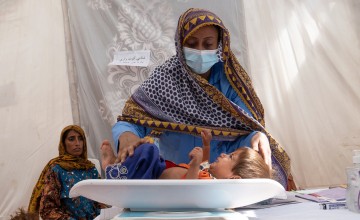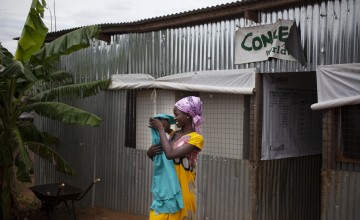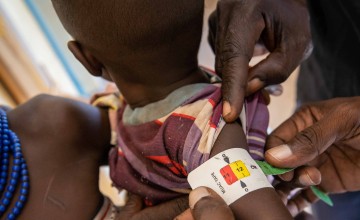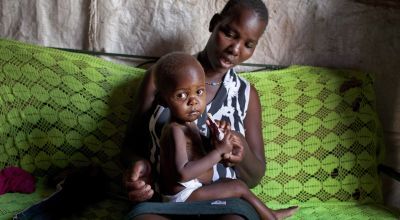
Read our 2024 annual report

Knowledge Hub
Human development is not possible without good nutrition, particularly for women and young children.
Yet these remain some of the biggest populations for cases of malnutrition and undernutrition. And while anyone can go hungry, child hunger carries even greater risks and impacts. Here are five reasons why — along with what Concern is doing to address these challenges.
1. The first 1,000 days of a child’s life are the most critical for nutrition
The first 1,000 days between pregnancy and a child’s second birthday are critical to a lifetime of health and development. Once a mother becomes pregnant, the nutrients she absorbs from her food are passed on to the embryo, and set the standard for how the child will grow and develop in the years that follow.
Malnourished mothers are more likely to give birth to malnourished children. Even if the child is born healthy, an early case of acute malnutrition can leave a lasting effect (more on that below), or prove fatal. Nearly 50% of all child deaths under the age of five are due to malnutrition and suboptimal breastfeeding.

2. Experiencing malnutrition during early childhood can come with a lifetime of consequences
Without proper postnatal care and the right feeding practices in place, newborns face a high risk for malnutrition. If a child survives into adolescence and adulthood, they could still face a lifetime of issues.
Stunting (low height for age) and wasting (low weight for height) are two key development issues that could hinder a child’s progress. Without adequate nutrition, a child’s immune system may become compromised as it develops, leaving them more susceptible to disease and illness. Their brains may also remain underdeveloped, which can leave them behind in school and with fewer opportunities to break out of poverty as adults. Hungry children are also more likely to develop certain noncommunicable diseases including diabetes, heart disease, and some types of cancer.
3. Children living in conflict zones are twice as likely to go hungry
Hunger and conflict often become cyclical, with food supplies dwindling as violence becomes more protracted or families living in refugee or displacement communities where supplies (including food) are often at a premium. Children caught in conflict zones are twice as likely to go hungry (or even starve) than children living in areas that are conflict-free. In fact, 45% of stunted children live in conflict-affected areas.
What’s more, over 40% of displaced people and refugees are children — including many that are left to care for themselves and younger siblings.

4. Girls are more likely to go hungry than boys
Simply put, hunger is sexist. 60% of people experiencing food insecurity at the moment are female and, in nearly two thirds of the world's countries, women are more likely to go hungry than men.
Girls are caught in this gender imbalance as well: Men and boys are often prioritised when it comes to meals. However, girls’ nutritional needs are just as great as boys’ — as they enter adolescence, good nutrition also becomes key for those who eventually go on to have children. Underfeeding girls often perpetuates an intergenerational cycle of malnutrition — one that, for babies in the womb, is equal opportunity.
5. More than 3 million children die from hunger every year
Severely wasted children are nine times more likely to die than a well-nourished child. Stunted children also face higher mortality rates, often later in life due to the non-communicable diseases that they’re more likely to develop. Micronutrient deficiencies also contribute to early mortality and disability.
Many of these deaths aren’t from hunger outright, but due to the child’s immune system being weakened or compromised due to hunger. Meaning that, with the right nutritional support, they are preventable.

We’ve made progress towards ending child hunger in the last few decades: In 1990, the mortality rate for children under five years was 1 in 11. In 2020, that rate was 1 in 27. However, with a high number of countries in conflict, climate change, and ongoing school closures due to Covid-19, we’re losing ground in the fight against hunger and, as we can see, children are hit hardest by this reality.
Child hunger: Your Concern in action
Last year, Concern reached 11.4 million people through our Health & Nutrition programmes, many of whom were adolescent girls, pregnant and lactating women, and children. These groups remain the core focus of our nutrition strategy, the goal of which is to ensure the world’s most vulnerable children and women of reproductive age receive the nutrition and support they need to survive and thrive.
One way we achieve this is through our award-winning programme, Community Management of Acute Malnutrition (CMAM). Developed in 2000 and now regarded by the World Food Programme as the standard for treating acute malnutrition, CMAM has saved millions of lives by centering the screening and treatment for acute malnutrition in the home — with support from community healthcare workers and local or mobile clinics.

CMAM is often administered as part of larger, integrated projects that help families achieve financial independence and food security. For example, we paired it with our Graduation programme in both Ethiopia and Kenya for the LEAF Project. Funded by Archer-Daniels-Midland, LEAF (Lifesaving Education and Assistance to Farmers) addressed both the short-term needs of malnutrition in communities, while helping participants to improve their farming practices in response to the new realities brought on by climate change. In 2021, for the first time in three decades, there was no need for humanitarian food distributions among the 20 communities in Kenya’s Tana River County that participated in LEAF.
Drawing on over 50 years of experience in nutrition programming, Concern recently developed ERNE (Enhanced Responses to Nutrition Emergencies). This three-year, EU-funded programme treats severely-malnourished children while simultaneously strengthening local health systems’ abilities to respond to (and even prevent) surges in malnutrition. A pilot programme is running in five countries — the Democratic Republic of Congo, Ethiopia, Niger, South Sudan, and Sudan — and in its first year reached over 342,000 people.




